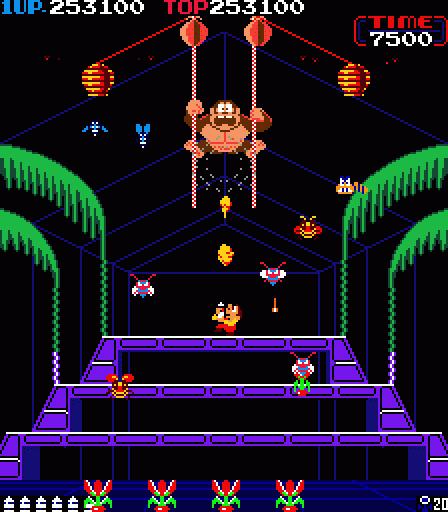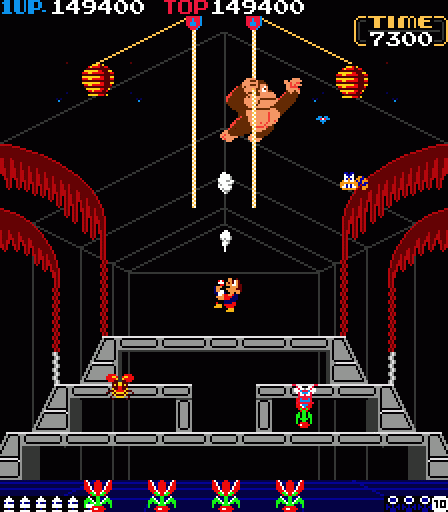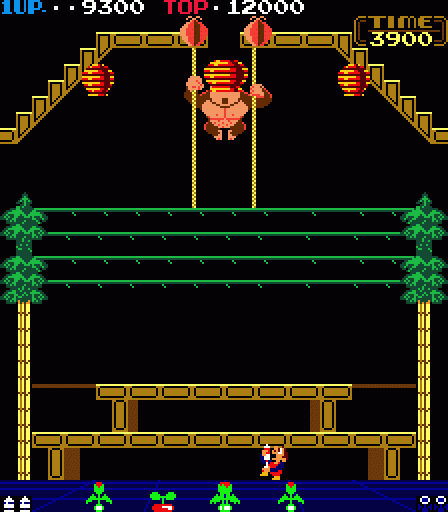Man, I used to think Zelda II was the official Nintendo black sheep. But you guys and your preemptive strikes against Donkey Kong 3 have made me change my mind entirely.
Donkey Kong 3 is weird, to be sure. It represents a radical shift in style, tone, and structure from the previous Donkey Kong games. It’s a platformer only in the most rudimentary sense of the word. It doesn’t star Mario. The internal narrative makes no sense whatsoever.
To appreciate Donkey Kong 3, you have to look at it in a broader context than simply its predecessors. This was an attempt to do several things at once… and, much like the game mechanics featured herein, this duality of purpose made it rather confusing.
For starters, Donkey Kong 3 debuted a few months after Mario Bros. The former didn’t feature Mario, and the latter didn’t feature Kong. We can safely assume that Shigeru Miyamoto, Gumpei Yokoi, and whoever else was involved in these games’ design worked on them at least somewhat in parallel. Clearly they recognized that Mario was at least as appealing a character as Kong and hoped to spin him into his own games with his own identity. In fact, they probably saw in Mario more of a future for sequels than Kong. Mario had a surety of purpose; Kong was all over the place. (Case in point? This game.) Players had never actually controlled Kong himself. He was a MacGuffin, a nemesis, an objective, but not a protagonist. And if we’re to believe Cranky Kong is the original DK, that means the original DK has never been playable in any form.
Not surprisingly, we didn’t see another original Donkey Kong title for more than a decade after this. He just didn’t make for as interesting a game as Mario.
The other goal behind Donkey Kong 3, one assumes, was to bring some Nintendo history full circle. Like Mario Bros., Donkey Kong 3 feels like an older arcade game, a regressive step back from the ever-changing, goal-oriented design of Donkey Kong and Donkey Kong Jr. It’s a score attack, pure and simple, a twitch shooter in a single stage whose format never significantly changes, only its paint job. But, as with Mario Bros., Nintendo was presumably thinking in terms of the looming home port and the restrictions of space that would entail. Indeed, Donkey Kong 3 hit the Famicom within half a year of its arcade debut.
Another possibility for these games’ simplified format presents itself as well: The original Donkey Kong was coded by a third party, Ikegami Tsushinki, and Donkey Kong Jr. was allegedly based on that code without the programmers’ consent. The two companies parted ways under strained conditions (litigious conditions, as a matter of fact). Mario Bros. and Donkey Kong 3 appear to have been Nintendo’s first attempts to bring development entirely back in-house, and as such their programmers may not have had the expertise necessary to create works as complex and intricate as the original Kong. That skill would certainly come in time (as Super Mario Bros. and The Legend of Zelda prove), but in Nintendo’s projects from 1983 may demonstrate them doing the best they could. Of course, this is all speculation based on bits and pieces I’ve gathered from other resources, but certainly those bits and pieces seem to fit together. If anyone has more concrete information, please, straighten me out….
Anyway, the Nintendo history angle: If Donkey Kong 3 feels regressive, that’s because its design draws on a much older Nintendo game, an early Space Invaders-style shooter called Space Firebird. Many of the enemies in Donkey Kong 3 behave exactly like foes that appeared in Space Firebird, most notably the way certain bees zoom down and explode into four deadly fragments of shrapnel when destroyed.
This doesn’t mean Donkey Kong 3 is a direct reworking, though. It adds a lot of new elements, many of which are seemingly culled from other popular games of the time. As you fire at foes with a DDT pump, enemy bees are swooping down in an attempt to steal the vegetables lined up along the bottom row of the screen. They pluck them away, then dart back up to their hives — a trait seemingly adopted from Defender‘s alien abductions. Successfully stealing a vegetable transforms a basic bee into a much deadlier form, just like Defender‘s Mutants. Meanwhile, caterpillars will drop to the platforms below, making the ground itself treacherous, very similar to the errant sparks that attempt to rise up and circle the rim of the tube in Tempest. Or maybe like that obnoxious spider in Centipede.
But most of all, Mario’s erstwhile replacement, Stanley the Bugman, isn’t simply gunning down enemies. There’s no way to clear a round by simply destroying bees. Your true objective in Donkey Kong 3 is to blast Kong in the rump with the DDT gun until he scoots his way off screen. Everything else is simply a distraction; you can win a round without ever shooting a single insect, and the faster you can force Kong to the top of the greenhouse the less danger you’re in of the bugs stealing your plants.
Why has Kong decided to harass a simple gardener? God knows. But he’s clearly the antagonist here, throttling beehives to enrage the bugs within until they swoop down and attack Stanley. It’s weirdly macabre, too; when Stanley fails, he doesn’t simply fall over with a halo above his head. No, he stumbles to the ground and a swarm of bugs swoops down and covers his body, then disperses, leaving… nothing. (15 years later, Hideo Kojima would totally rip this off for Vulcan Raven’s death scene.)
Oh, and there is one little nod to Donkey Kong tradition: At the end of a stage cycle, Kong gets his head stuck in a beehive and falls to the ground, stunned. So there’s a sort of narrative arc, even if it makes no real sense.
Donkey Kong 3 is a little too complex and abstract for its own good, but — and this is the important thing — it’s not a bad game. A bad Donkey Kong sequel, perhaps, but fun in its own right. Honestly, the fact that Nintendo didn’t do anything with Kong for the next decade outside of an edutainment spin-off and making Junior a racer in Super Mario Kart suggests that they knew they’d run out of good ideas for the character at this point. One can only wonder what the abortive Return of Donkey Kong for NES would have been. With luck, Satoru Iwata will ask Shigeru Miyamoto about it some day for our edification.
In any case, Donkey Kong 3 turned out to be a sort of evolutionary dead-end that had nothing to do with Mario, and barely anything to do with Donkey Kong. Still, taken for what it is — a simple reworking of a very early arcade game — it’s really not too shabby. The difficulty ramps up quickly, and it does a good job of throwing new and different hazards into the mix as you advance through the levels. A solid game, if not exactly a worthy successor to one of the greatest arcade games of all time. But that would come soon enough.



Wait… Cranky Kong is the original Donkey Kong? Oh man that’s sweet.
It is broadly hinted, yes.
I’ve heard that before. As much as I really don’t care to make sense of Mario back stories, if Cranky was the original Kong, wouldn’t Mario and Pauline be old whippersnappers as well? Or was Cranky Kong reminiscing about exploits against some proto Mario character we have never seen? And if Donkey Kong retains the the same name as in the original game, doesthat mean that Donkey is not a name but some kind of title for the Current Alpha Kong? And is that suposed Cranky being Donkey Kong story a Rare creation or from Nintendo. I don’t really buy it.
I suppose this will be a point of contention when they release a Donkey Kong Historia book, but given that the games don’t have a complex narrative and it’s a funny joke, it’s better to just relax. Mario is immortal and getting hit by beehives and dropped off towers had a debilitating effect on the old Donkey Kong.
Well, hasn’t it been said that adventure keeps one young? And if they sidelined DK for a decade while Mario kept on trucking…
As for the bit about Cranky being the original, that’s come from both Nintendo and Rare, so…
Also, it’s unfortunately not true about Cranky/original DK never being playable, though I wish it was. He’d been playable in some of the spin-off titles, like that barrel racing game and the Swing-style games. Such a waste… imagine if he was playable for the first time in a Smash Bros. game, where get gets all Master Roshi/Miyagi/Yoda on you.
Donkey Kong 3 may not be much of a Donkey Kong game, but I really like it as a shooter. Shoot bugs, protect flowers, spray gorilla in ass to complete the stage.
If nothing else, Donkey Kong 3’s got a quirky theme for a shooter, and quirk’s a big part of what makes the genre interesting.
It always felt like a more comical take on Galaga, especially with the big-eyed boss bugs that take two hits to destroy. The best part of the game is getting that super sprayer that turns you into a hiney-spraying murder machine. Even the worms on the vines are no match for you when you’ve got that can of extra-strength DDT! The wacky little tune that plays in the background while you’ve got the power up is terrific, too.
Also worth noting is the Game & Watch title Greenhouse, available in the first DS Game &Watch Collection (yeah, that one you could only get from Nintendo by collecting Donkey Kong cereal boxtops, or whatever). It’s an entirely different game, with Stanley being attacked from all directions by bugs intent on munching his flowers. It’s got that tension-filled spinning plates gameplay that makes the Game & Watch series so compelling in spite of their simplicity. On top of that, it’s a dual screen game, which generally offered the best G&W experiences.
I was actually going to mention the Donkey Kong 3 Micro Vs Game & Watch! For the longest time, I had no Nintendo made a DK3 arcade machine or NES game.
I just remember that green case with two small, extendable controllers. And a really wide screen.
Can’t remember at all if it was any fun.
Ha! Oh man, I forgot about that one… it’s completely different from both the arcade version of DK3 *and* Greenhouse. I’m jealous of anyone who managed to keep a Game & Watch Vs. unit… next to the fabled crystal edition of Super Mario Bros. (with the see-through screen) it’s the rarest of these handhelds.
I’ll admit to not caring much for Donkey Kong 3, but I do feel a little bad for ol’ Stanley there. For a game that got both an arcade and console release in multiple territories, Stanley the Bugman gets less nostalgia love than almost any other Nintendo character of the era. The titular character from Devil World gets more love and that thing never left Japan.
Yeah, Nintendo should find a way to bring Stanley back. I’d say to give DK3 the DK94 treatment, but they’d probably just replace him with Mario. =
Actually…
The original DK was playable in… Donkey Kong 3.
No, it’s not some super-secret mode, but, in fact, is the Game and Watch version, that pits a playable DK against Stanley in a wackier set-up than this game.
😀
Hmm, were the comments here changed again recently? I’m noticing there are no longer any checkboxes to be notified of new replies.
Uh, wait, you CAN clear a level by eliminating insects (in the NES version, at any rate). There’s a finite number of them and once they’re gone Kong sheepishly climbs to the next scene.
In fact taking this approach turns DK from a goal to more of a timer that the player has to remember to reset occasionally lest they lose a life. This approach is also the most efficient means of point scoring, so…
Wow, really? I was never able to do that. I’ll have to experiment some more.
http://www.youtube.com/watch?v=TgpX3LCtMjo&t=1m7s
Though I may be wrong the scoring efficiency (at least when a super spray is available, then by a means spray the monkey)
Ikegami? The one time I saw their name in public was on the side of a commercial video camera used in a big church.
Look them up. They’re primarily an electronics manufacturer, but based on data in the code for DK and some documents pertaining to a lawsuit, they’re believed to have been the people who did the coding for DK.
You forgot DK ’94 when listing Donkey Kong games between DK3 and Country. It was only a few months before Country, but it was before Country.
Well, I do find your hypothesis of why this game was as underwhelming as it was pretty sound, Jeremy. Thanks for dissecting DK3! Keeping it simple for an easy famicom port, and Nintendo´s early attempts at coding their games themselves. Makes perfect sense, and also they were waving goodbye to the arcade scene to center on their new home console, where they certainly put their top talent to work. Little could anyone suspect the kind of magic Miyamoto was going to get out of that machine! And they thought single screen, black background, repetitive action games was as good as it was going to get…